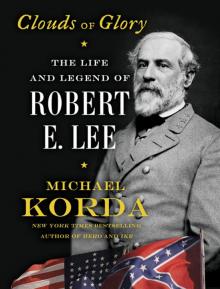- Home
- Michael Korda
With Wings Like Eagles: A History of the Battle of Britain Page 4
With Wings Like Eagles: A History of the Battle of Britain Read online
Page 4
Honors rained down on Baldwin—he was made a knight of the Garter and an earl—but he got no credit for the most important accomplishments of his political life. For by 1937 the “Chain Home” (CH) radar network was already in place and operating, silently and secretly, and the first Hurricanes were reaching RAF Fighter Command squadrons, to be followed a year later by the first Spitfires; Dowding had been appointed Air Officer Commanding-in-Chief of Fighter Command almost a year ago; and Dowding’s special brainchild, the central Operations Room at Fighter Command Headquarters, was completed and functioning. There were problems, of course—not surprisingly, considering the amount and variety of revolutionary science and technology involved—but one by one they were being solved.
Whatever else might happen, Britain would no longer be completely undefended in the air.
CHAPTER 3
“I Can’t Understand Why Chicago Gangsters Can Have Bulletproof Glass in Their Cars, and I Can’t Get It in My Spitfires!”
—Air Chief Marshal Sir Hugh Dowding, KCB, 1937
The decision to place Dowding in command of the newly named Fighter Command was made while Baldwin was still prime minister, and was already clouded by the low esteem in which Dowding was, even then, held by the other members of the Air Council, and by the enmity, going back to their days as army subalterns in India, which existed between himself and the next Chief of the Air Staff Air Chief Marshal Sir Cyril Newall—an enmity made stronger by Dowding’s belief that he had been promised the post of Chief of the Air Staff, and that because he was senior to Newall it should have been his. To say that Dowding was a difficult colleague would be putting it mildly—he was impatient not only with fools, but also with people who did not agree with him, whatever their rank; he was also, despite a forbiddingly conventional appearance, a man of vision and imagination, always open to unorthodox new ideas, and although generally uncommunicative, he was argumentative when it came to things that mattered to him, and not easily open to compromise. The members of the Air Council were happy to be rid of him and his crank ideas, and since they believed that fighters were a distraction from the all-important task of building up the bomber force, Dowding’s new command was not, in their eyes, a promotion—on the contrary, they felt they had rid themselves of a uncongenial nuisance and sidelined him to a place where he could presumably do little or no harm until his retirement. The notion that Fighter Command would become the “first eleven,” to use a cricket term for the top players, and the fighter pilots rather than Bomber Command the glamour boys of the RAF had not yet occurred to Dowding’s colleagues. The duration of his command and the date of his retirement were already abrasive issues long before the Battle of Britain, and Dowding knew it—a skilled military bureaucrat himself, he was always obliged to fight on two fronts, one against the Luftwaffe and the other against his enemies on the Air Council; and although he would prove victorious in the first battle, he was defeated in the second.
As Air Member for Research and Development on the Air Council, Dowding had laid the groundwork for Fighter Command, often against stiff opposition. He had backed Watson-Watt’s experiments in radar, and helped to transform scientific theory into a solid chain of radar transmitters along the southern coast of England. He had been instrumental in laying down the Air Ministry’s specifications for a new generation of revolutionary eight-gun, all-metal monoplane fighters, with an enclosed cockpit and retractable undercarriage, and encouraged Rolls-Royce in its private venture to develop a super-charged twelve-cylinder aero engine, called the PV XII and eventually named the Rolls-Royce Merlin. He had insisted that future fighters be equipped with high-frequency wireless sets, enabling the pilots to talk to each other and to communicate with the ground, and even foresaw the need to link the radar operators to an operational center that would transmit to the fighter pilots the information they needed in terms they could understand in order to intercept the enemy in what we would now call “real time.” Like all visionaries, he was impatient, and he also intuitively understood that great change would meet with suspicion and hostility even from those who would most benefit from it. The aircraft industry was not at all sure that the Air Ministry’s specifications could be met, or that it would be possible to mass-produce any design that could meet them. Fighter pilots who had been brought up in the Biggles tradition* of aerial lone wolfsmanship were appalled at the notion that they would be told where to fly and what to do over the radio by young women—for Dowding had already guessed that the only way to provide the number of people who would be needed to transmit the endless flow of information from the radar stations to Fighter Command’s Operations Room, and from there “filtered” to the operations room of each group, and on from there to the squadrons and the pilots in the air, would be to employ large numbers of young women. Maintenance units were aghast at the new tasks the ground crews would have to learn and the sheer quantity of unfamiliar new tools and spare parts they would need to deal with. An air force in which repairs to fuselage and wings still involved sewing and doping fabric patches, and air-to-air communications consisted of the flight leader sticking his arm out of the open cockpit of his aircraft and making hand gestures, was going to have be dragged into the mysteries of stressed, flush-riveted aluminum skin and high-frequency wireless, and there was bound to be some kicking and screaming, much of it directed at Dowding.
Fighter Command Headquarters had moved into its new home, Bentley Priory, only two months before Dowding’s appointment.1 Not far from Harrow and Stanmore, and only ten miles from London, Bentley Priory was a huge but architecturally uninspiring eighteenth-century house, originally the property of the marquess of Abercorn, which had been converted first into a hotel, then into a girls’ boarding school. Finally it ended up in the hands of the RAF in 1926, another of those stately homes, fallen into ruin, which only the government could afford to maintain. Bentley Priory sprawled all over, the original eighteenth-century house dwarfed by less harmonious structures that had been added to transform it first into the hotel and then into the school. Inside, much of it was a rabbit warren of rooms and passageways, but it retained a magnificent entrance hall, a grand staircase, a ballroom, two billiard rooms, a picture gallery in the form of a rotunda, a library, a gymnasium (added on during its days as a school), and, perhaps its strongest asset, a beautiful garden in the eighteenth-century classical Italian style that provided a serene and imposing view from the rear of the house. In the mid–nineteenth century it had been the home of the dowager queen Adelaide, widow of William IV; for her bedroom, an ornate Italianate ceiling was painted, which was for a time regarded as one of the architectural wonders of England. Among those who had visited the house in its grander days were Queen Victoria, the duke of Wellington, and Nelson and Lady Hamilton. Visitors coming up the drive who had business at Fighter Command sometimes remarked that it looked like a lunatic asylum, and it might have become one had the air force not bought it cheap, for less than £25,000.
Dowding’s office, nowadays preserved as it was in 1940 as a kind of shrine, looked out through floor-to-ceiling French windows over the Italian garden, and like the man himself it was, apart from the view, spare—a Ministry of Works desk; a few uncomfortable, nondescript chairs that may have been part of the headmaster’s furniture when the house was a girls’ school; a conference table; a telephone. There were no personal photographs or souvenirs, and the surface of the desk was kept uncluttered. Dowding, while not a martinet, was a model of military propriety—other officers at Bentley Priory walked around indoors without wearing their caps, since capless they didn’t have to be saluted or to salute back, but every time Dowding left his office he put his cap firmly on his head, the gold-braided visor dead straight and exactly parallel to the ground. Not for Dowding, either, a cap worn at the jaunty angle favored by popular admirals, or a cap with the top crushed like those of his pilots. Dowding’s headgear, like Dowding himself, was uncompromisingly correct, to the extent that in photographs of Dowding and George VI toge
ther, the king looks more casual in RAF uniform than Dowding does. The Air Ministry acquired Montrose, a large, ugly, mock-Tudor house in suburban Stanmore, for Dowding’s use, and he moved his sister Hilda in to look after him, then set about building the kind of organization he had in mind.
With a clairvoyance exceeding that of his fellow air marshals, let alone of the government, Dowding had a good picture in his mind of the battle to come, and what it would take to win. Fighter Command Headquarters, he had already determined, would not just control the fighter squadrons; it would have to control the entire battle. Thus, from the very beginning, he set out to fill the vast space of Bentley Priory with the people he needed. There would have to be a naval liaison officer, for example, to keep track of naval and merchant marine movements and to warn the navy of raids aimed at its home ports; there would have to be integrated control of the army’s antiaircraft (AA) guns and searchlights, requiring the presence of senior officers of the Royal Artillery to ensure that the AA gunners shot down Germans, not Dowding’s pilots. There would also have to be barrage balloons, the Observer Corps (volunteers—spread out across southern England and equipped with binoculars, military telescopes, compasses, and direct telephone lines to Fighter Command—whose task it was to count enemy planes and calculate their direction), civil authorities responsible for sounding the air raid sirens in each town and district as air raids approached them, and so on. All these elements, many of them not part of the RAF at all, had to be firmly unified under a single command, responsible for the total air defense of the United Kingdom. That, as Dowding saw it, was his job, and it says much for his energy, his determination, his sense of urgency, and the sheer sweep of his ambitious plan that he was able to deflect most of the Air Council’s attempts to hamper him by rejecting or scaling down his requests, and the natural tendency of the Civil Service, the police forces and fire brigades, the army and the navy, and the civilian Observer Corps (which had hitherto been the responsibility of the Home Office) to resist being told what to do by an air marshal.*
Among the many things that Dowding demanded and the Air Council tried to reject were laminated armored-glass windscreens for his fighters; buried, concrete-shielded telephone lines from Bentley Priory to the radar sites and the Fighter Command airfields; all-weather concrete runways, which had hitherto been thought necessary only for bombers; an underground bombproof Operations Room at Fighter Command Headquarters; eight guns for the Spitfire and the Hurricane (the Air Council thought four were plenty); and the rapid formation of the Women’s Auxiliary Air Force (WAAF) to provide him with the radar operators and plotters he needed.
Dowding won most of these bruising fights, but not without making further enemies. The younger air marshals, such as Air Marshal Sir William Sholto Douglas, KCB, DFC, MC, thought Dowding was out of touch—it had been too long since he had flown an airplane, and he failed to appreciate that bombers, not fighters, would be what mattered in the war to come. As for the older air marshals, they had learned to fly on grass fields in aircraft with open cockpits, and were impatient with such frivolous, expensive, pie-in-the-sky notions as bulletproof glass. Even the idea of burying a fighter’s battery of guns in its wings struck some of them as foolish. They had fought when a fighter aircraft mounted two machine guns above the engine, placed so the pilot could clear a jam or a frozen breechblock by pulling back on the cocking lever from his open cockpit, and if that failed, lean forward out of his seat and give the breech mechanism a sharp blow with a rubber mallet, which most pilots carried in the cockpit for just that purpose. For that matter, Fighter Command’s inventory of aircraft still consisted mostly of biplanes with an open cockpit, fixed undercarriage, and two guns, not very different from those of the last war. They objected to the transparent sliding cockpit canopy, arguing that the pilot would be unable to turn his head and look behind him, and were unconvinced by the fact that Dowding had insisted on the provision of a perfectly ordinary rearview mirror, like that of a car, for just that purpose.*
It should not be assumed from all this that Dowding was invariably right and the Air Council always wrong, or that the air marshals who opposed him were foolish. Their mandate was to devise ways to use air power to win a war—defense of the homeland, or what Dowding liked to call the “Home Base,” was a secondary issue—and to do so on very tight budget, over which Treasury watched with the eyes of a hawk. What is more, they were charged with projecting British air power over the whole empire, a worldwide commitment, which they were expected to carry out on a shoestring budget with obsolescent aircraft. Both they and Dowding himself recognized that whatever else they might do, fighter aircraft could never win a war; only bombers could do that. (Some of the members of the Air Council, including Newall, had been instrumental in drawing up the specifications for the new generation of fighters—it was not so much the fighters they objected to, it was Dowding’s single-minded fixation on them.) The difference between Dowding and his colleagues, however, was that Dowding understood that without modern fighters Britain might lose the war the moment it began.
Across the North Sea, the Germans were having the same kind of arguments. When Willy Messerschmitt first demonstrated his revolutionary new all-metal monoplane fighter, the Bf 109, both Göring and his old squadron mate and fellow ace from Richthofen Squadron, Ernst Udet—the daredevil aviator and bon vivant who was in charge of the Luftwaffe’s development and research, a position rather similar to that of Dowding when he had been on the Air Council—remarked that it might make a pretty nice fighter if Messerschmitt took the cockpit canopy off and gave the pilot an open cockpit he could see out of; they showed no concern that the original prototype called for an armament of only two machine guns mounted in front of the pilot, just as it had been on the Fokkers and Albatrosses they had flown during the war. Udet at least was finally converted when Messerschmitt pointed out that at a speed of 350 to 400 miles per hour there was no way a pilot could stick his head out and turn it in the slipstream, but Göring remained deeply suspicious of the whole idea. It was not only on the British side of the North Sea that radical change in aircraft design and technology was being resisted.
Still, miraculously, Dowding got most of what he wanted, starting with the construction of the radar sites, each with four 300-foot-tall steel lattice transmitter masts and four 240-foot-tall wooden receiver masts (there was great concern at the Air Ministry over their effect on birds, and bird shooting) long before it was clear that radar was reliable. At this time, radar still gave many false readings, failed to accurately determine height, was an unreliable indicator of the number of aircraft in a formation (hence the importance of the 1,400 Observer Corps outposts, to count them visually once the enemy formation was in sight), and could not yet distinguish between enemy and friendly aircraft.*
The radar sites were to be placed so that they overlapped, giving complete coverage of the eastern and southern coasts of England, and were easily able to pick up signals from aircraft in the skies over the Netherlands, Belgium, and northern France, though of course nobody on either side in the mid- to late 1930s had any reason to suppose that the Germans would one day have bases there. By 1937 the first of these sites was in operation, and by 1939 there would be fourteen more—an immense job of construction and a huge expense for a scientific will-o’-the-wisp that might not work, all of it initially authorized by the supposedly lethargic Stanley Baldwin, and carried forward by his successor as prime minister, Neville Chamberlain, who is better remembered for Munich.
Looked at in this light—as it seldom is—the policy of appeasement, which was later to come in for such scorn, may be seen, at least in part, as a successful effort to buy time. The CH radar network would not be fully operational until 1939, and the government knew it; nor would Fighter Command begin to receive its Hurricanes until 1937 or the first of its Spitfires until 1938. Given the fear of bombing and the widespread belief that a modern war would begin with an effort by the Germans to destroy their enemies’ major cities f
rom the air in one blow (a belief shared by the left and by the right, and by such very different personalities as H. G. Wells, Stanley Baldwin, and Winston Churchill), it is hardly surprising that Neville Chamberlain, who was also faced with a succession of French governments even more determined not to be bombed by the Germans than the British were, chose to propitiate the Führer rather than to threaten him with war. We know now, of course, that a knockout blow against London or Paris was the last thing Hitler had in mind, and that the Luftwaffe was in any case in no position to carry it out, but at the time nobody could be altogether certain of that. Since the general public was unaware of the existence of radar, or of what would be its vital importance in protecting Britain, most people still believed, as Baldwin did, that “the bomber would always get through,” and hardly anybody argued otherwise. Dowding’s towers were in fact the first step in making that assumption false.
Interestingly, the towers aroused very little curiosity or comment at the time they went up, beyond the concerns of bird lovers; nor do they appear to have kept anybody in the Luftwaffe awake at night. Radar was not in itself a secret—like nuclear physics, it was a well-known, if specialized, area of scientific research, and it was being experimented on, with varying degrees of enthusiasm and success, in the United States, Germany, and the Soviet Union as well as Great Britain. It was not so much that the British had made a scientific breakthrough as that—unlike anybody else—they had taken the experimental equipment out of the laboratory and placed it in the field. At first it was literally in a field, where it was tested against an RAF bomber. Then the British worked out by trial and error how to make practical use of it as a long-range early warning system; began to train operators—not scientists, but ordinary airmen (and soon airwomen)—to read and interpret the amorphous blips and squiggles as they appeared and pulsated on a radar screen; and drew up ambitious plans to put the whole system in place as rapidly as possible, and on a huge scale. The Germans had nothing like it; nor did the Americans; and neither did the unfortunate French—in fact, the lack of radar would be one reason for the total failure of the Armée de l’Air in May 1940. The French had no radar, no central fighter command, no strategy for using the fighters they had in abundance; even the far superior British Hurricanes sent to France to support them were wasted, just as Dowding had grimly predicted they would be, since without ground-based radar and fighter control their pilots were no better equipped to find the German aircraft or concentrate against them than fliers had been during World War I.

 Passing
Passing Another Life
Another Life Clouds of Glory
Clouds of Glory Hero: The Life and Legend of Lawrence of Arabia
Hero: The Life and Legend of Lawrence of Arabia Cat People
Cat People Hero
Hero With Wings Like Eagles: A History of the Battle of Britain
With Wings Like Eagles: A History of the Battle of Britain Ulysses S. Grant
Ulysses S. Grant